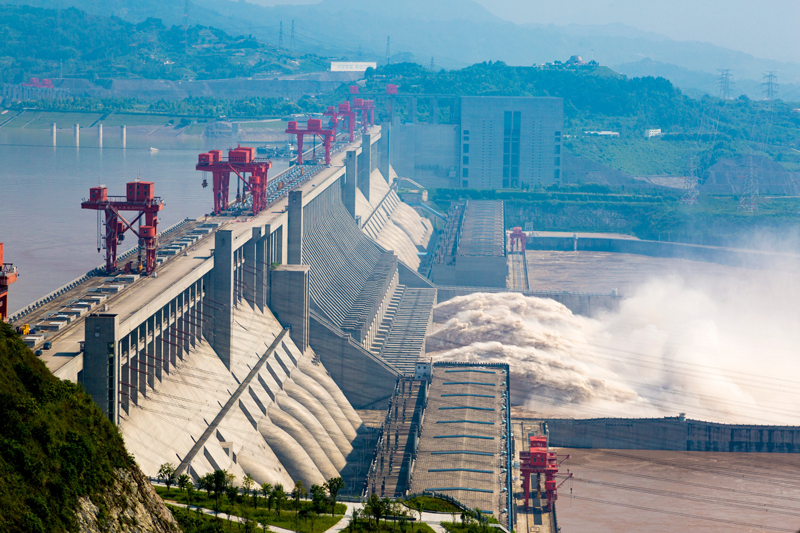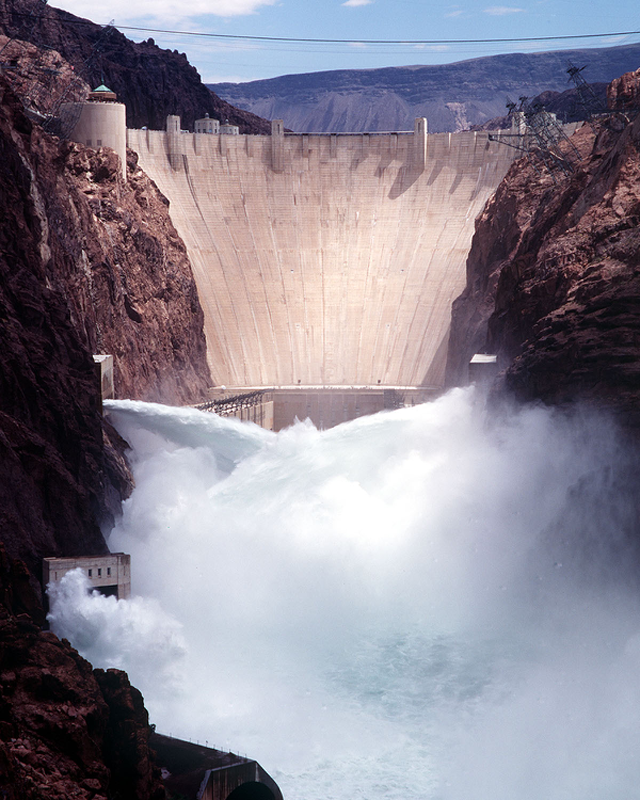Water makes up 71 percent of the Earth’s surface and 60 percent of the human body. It creates and sustains life. It’s abundant and powerful enough to destroy whole cities. It’s no surprise that we’ve found a way to harness the force of this mighty, readily available resource. Hydropower uses rapidly moving water to generate renewable, inexpensive, reliable and adaptable electricity.
The Greeks began using descending water more than 2,000 years ago to turn wheels that would mill wheat into flour. Mechanical hydropower was used to pump and mill regularly in the 1700s. In the past, hydroelectric power accounted for a much larger percentage of electricity used in the United States than it does currently. About 40 percent of the power that we used in the early 1900s came from hydropower, and, in the 1940s, it generated 75 percent of the power in the West and Pacific Northwest. Those percentages have since dwindled as fossil fuels have become the main energy source. Today, it only accounts for approximately 10 percent of the electric power generation in the U.S., according to the Bureau of Reclamation.

Wendy S. Kalidass, supervisor of Electric Reliability Compliance – Hydropower Division in Denver, Colorado, shines a little light on the history of hydropower in the U.S. by adding, “During the 20th century, the Federal Government invested enormous resources in water infrastructure throughout the western United States to help develop the West, reduce flood risks to communities, provide reliable water supplies for farms, families, businesses, fish and wildlife, and generate dependable, renewable hydropower.”
In the renewable energy sector, hydropower is the standout, producing 60 percent of all sustainable power across the globe. When you include fossil fuels and nuclear power in the overall mix, the number decreases substantially, but is still significant, at 16 percent worldwide. The majority of renewable energy in the U.S. is created by water, which mirrors the ratio of hydropower to other renewables universally. It is considered the preferred method of electricity generation in areas that have an abundance of flowing water; in Norway, hydropower is the source of 99 percent of the country’s power.
In 2019, international hydropower electricity generation and generation capabilities hit an all-time high; the installed capacity, or the amount of energy that a station can produce at a given time, was 1308 gigawatts, and a whopping 4306-terawatt hours were generated. The U.S., along with India, China, Canada and Brazil, is one of the world leaders in terms of installed capacity.
The Three Gorges Dam in China is the largest hydropower plant in the world, producing approximately 90-terawatt hours yearly and supplying 70 to 80 million households with power. On a personal note, a dam that is near and dear to my heart and forever will be cemented as a part of one of the most beautiful sites on the magnificent journey of my move from Texas to Portland, Oregon, is the Dalles Lock and Dam. I often would make the hour drive out to the Dalles just to gaze at the gorgeous scene, a large flowing river surrounded by mountains covered in gigantic Christmas trees.
The Columbia River in this region is quite a site. As vast as it is beautiful, it is now the location of one of the top ten largest hydropower plants in the U.S. Its total generation capacity is 2,160 megawatts, and its average yearly electricity production from 2010 – 2012 was 7,273,579 hours. Not only is the Dalles Dam used to generate power, it is also used for recreation, flood mitigation and irrigation, and contains fish ladders so that migrating fish can return to their spawning grounds. The Pacific Northwest is also home to the largest hydropower plant in the U.S., the Grand Coulee Dam, which helped make Washington the top contributor for total U.S. hydropower generation capacity at 27 percent in the summer of 2020.

Hydropower plants can be made with or without dams or reservoirs. Those with them can generate the most electricity. However, those without them are considered more environmentally friendly because they do not obstruct the natural flow of a river. There are different types of hydropower plants: diversion, impoundment and pumped-storage plants. Impoundment is the most widely used type and involves the use of a reservoir to store water in a dam. Water from the dam is funneled into a passageway, called a penstock, that houses a turbine. The water rotates the blades which triggers the generator to create electricity. Impoundment, or run-of-river, facilities take advantage of the natural flow of water by routing part of the river into a canal or penstock. Pumped storage facilities use the energy created by another power source, like solar, wind or air, to pump water from a lower reservoir to a higher one. This acts as a battery by storing power when the demand is low. When the electricity is needed, the water is released back into the lower reservoir and rotates the turbine.
Due to its energy storage services and flexibility, pumped storage hydropower perfectly accompanies fluctuating renewable power sources, such as solar and wind. On a still and shady day, it can pick up the slack. Kalidass says that hydropower provides “ancillary services [that] are valuable in areas that integrate renewable energy resources, such as solar power in the southwest and wind power in the Pacific northwest.” Pumped storage hydropower is the most massive battery equipment in the world, far outreaching all other battery types. It holds 94 percent of the world’s installed power, an estimated 9,000-gigawatt hours. In 2019, there were 158 gigawatts of pumped storage capacity from all sites.
Variable renewable energy (VRE) curtailment cuts back power generation at times when it is not needed (which means loss of potential electricity sales), but pumped storage can prevent this practice by saving the unused energy for a later date. Also, transmission congestion can occur when the grid is overloaded with excess power, which can lead to wire breakage, shorts and an overall decline in system efficiency. Pumped storage can mitigate this issue by taking on the excess electricity.
Kalidass says, “An important benefit of hydropower is its storage ability that provides contingency reserves available to the grid within seconds of identified critical needs. Hydropower plants provide essential back-up power during major electricity outages or disruptions. Hydropower was used for recent critical energy needs in California during the summer of 2020 and Texas in the winter of 2021.”
A clear advantage to hydropower is that it is a green alternative to fossil fuels. Compared to other forms of electricity, it has the lowest greenhouse gas emission concentration. Over the last 50 years, 100 billion tons of carbon dioxide transmission have been avoided using hydropower. The total carbon footprint of the U.S. is equal to that in a 20-year period. Four billion more tons of carbon dioxide a year would be released if current hydropower were replaced with coal. The use of hydropower can seriously mitigate the negative impact we have on our environment and benefit us all. However, in order to reduce the climb of the global temperature by two degrees Celsius by 2050, we must increase hydropower accommodations by 60 percent, or 2,150 gigawatts, from where it already is, according to the International Renewable Energy Agency (IRENA). Based on the current projects under way, by 2030 there should be an increase in storage capacity of 240 gigawatts.

Although the upfront construction costs of hydropower facilities are high, it produces relatively inexpensive electricity in the long run. In 2018, it was the least expensive form of power in most markets at 47 cents per kilowatt hour. In addition to cost, it has the advantage of long asset life; due to the water cycle, the same water can be used over and over again. Kalidass says that the Bureau of Reclamation “works cooperatively with federal, state, tribal and local entities to plan for and implement actions to increase water supply through programs such as WaterSMART, desalination and water purification research, cooperative watershed management, drought resiliency, snow water supply forecasting and water conservation field services.”
Kalidass describes the benefits of hydropower when compared to other forms of power generation. “Hydropower is a flexible and renewable resource that provides a reliable source of electricity and a suite of ancillary services to energy markets and the electrical grid. Ancillary services include contingency reserve, frequency response, load following, regulating reserve, black start capability -[the established ability of a generating unit to automatically continue running at decreased levels when detached from the grid] and reactive power support. Reliable, low-cost hydropower generated at 53 Reclamation projects provides tremendous value to the nation that has supported development of the western U.S. over 100 years through the provision of water and electric power to rural communities as well as ancillary services to support western interconnection grid reliability.”
Headline photo courtesy of U.S. Army Corps of Engineers Portland District. Dalles Lock and Dam in Oregon.
Shannon West graduated with a Bachelor of Liberal Arts in Psychology from Texas State University, where she developed a knack for writing research papers and case study analyses. After years of helping friends edit their university papers and cover letters, she is now putting those skills to use by copy editing and writing here at OILWOMAN Magazine.





